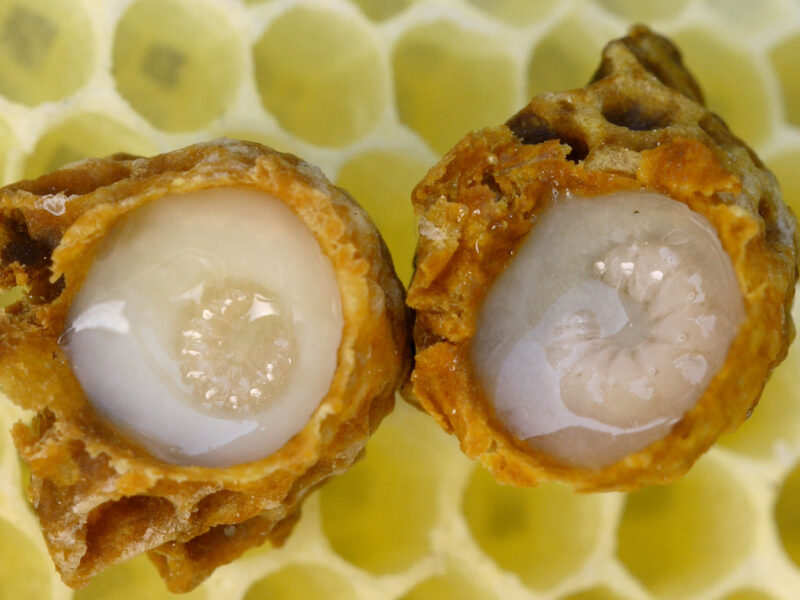

Every now and then, the joint at the base of my thumb gets cantankerous. Probably from playing too much Candy Crush to relieve the stress brought on by binges of TV news, but whatever the cause, it hurts. During one of those episodes last year, a bee happened to sting the base of my thumb while I was working in her hive and, like magic, the pain was gone, and stayed gone for a few days.
A little research showed that what I had experienced was accidental apitherapy — a fancy word that encompasses a broad range of bee-based health treatments. In this case, a sting delivered bee venom, or apitoxin, into an inflamed area of my body and reduced that inflammation.
Mentioned in both the Bible and the Quran, the use of venom, honey, royal jelly and other honeybee-related substances to treat various ailments dates back at least 5,000 years. Apitoxin can be extracted from bees and injected by an alternative health care practitioner, or a bee can be pinched until the stinger shows, and then used as a living acupuncture needle. This does not end well for the bee, which dies, and there have been times when it has not ended well for the patient, either. While the compound melittin in bee venom can reduce inflammation, it can also cause an anaphylactic reaction in rare cases, which may lead to death if not treated quickly.
A more controlled way of using bee venom medicinally is through use of venom that has been collected, dried and purified. It’s collected by placing electrical devices in a hive, which stimulate the bees to sting, leaving their venom on a plate designed for precisely that purpose. This method doesn’t kill the bees, and allows for greater control of the amount and specific content of bee venom used in treatment.
A paper published by the National Institute of Health in 2019 outlines the history of apitherapy and touches on some promising studies exploring bee venom and its components as a treatment for inflammatory disease like rheumatoid arthritis, as well as for neurodegenerative diseases like Parkinson’s, Alzheimer’s and ALS. Apitoxin has even shown some potential for inhibiting the growth of some types of cancerous tumors, according to the NIH paper.
While using apitherapy to treat life-threatening conditions is best left to the professionals, other bee-related products can be used in relative safety. Let’s start with honey, the tastiest. You probably already know that honey can soothe a sore throat and ease coughing. It can also relieve other cold symptoms — possibly because of antimicrobial ingredients naturally found in honey — as well, or even better, than over-the-counter cold medicines.
A spoonful of honey, a squeeze of lemon and a shot of Irish whiskey in a cup full of hot water is my favorite go-to for any cold or flu. Or, you know, just because it’s cold outside and we deserve some solace if winter is going to be unreasonable.
Raw, unprocessed honey is also used as an antibacterial agent, effective against salmonella, E. coli and roughly 60 other types of harmful bacteria, according to another NIH paper, and has been used to dress wounds and burns since ancient times. Granted, it’s messier than store-bought antibacterial creams, but it can promote healing and clears out bacteria quite effectively. Apply it to a wound, cover it with a bandage and let it go to work. Taken internally, honey can also help to relieve diarrhea and other gastrointestinal disorders.
While some say that eating local honey can help reduce seasonal allergies, the science is skeptical. The idea is that local honey contains pollen from local flowering plants, and consuming those small amounts of pollen could help the immune system build a tolerance, kind of like getting allergy shots. But there’s no guarantee that the local honey you’re getting is from bees who feasted on the particular blooms you’re allergic to, or that the honey has enough bits of pollen to offer adequate exposure.
Royal jelly, another bee product touted for its alleged health benefits, is a milky secretion made by nurse bees. It’s fed to all bee larvae for three days. After that, workers and drones are fed honey, while developing queens feast on royal jelly throughout their childhood. Rich in protein, carbohydrates, fatty acids, vitamins and minerals, royal jelly is what turns regular worker bee larvae into queen bees, complete with the functioning ovaries they need to lay eggs.
As a bee lover, I’m not crazy about the idea of harvesting royal jelly. Some beekeepers stimulate hives to produce queen bees unnecessarily, and after a few days of development, they remove cells containing the queen larvae and harvest the royal jelly. The larvae die, the worker bees are left with nothing to show for all their efforts to nurture new queens, and the hive’s natural order is upended, which is the last thing bees need. Each queen cell contains just a few drops of royal jelly, so this needs to be done at a pretty large scale to get enough royal jelly to make it worthwhile, and the health benefits are questionable. Advocates claim that taking royal jelly can ease the symptoms of PMS and menopause, promote fertility, fight diabetes and high cholesterol, give the immune system a boost, and provide other anti-aging benefits. Studies to date have been inconclusive.
Pollen, collected by honeybees as the primary protein source for the hive, is another bee product with purported health benefits. Bee pollen, or bee bread, consists of flower pollen granules mixed with nectar and bee saliva. There is some evidence that it can stimulate the immune system, and it is packed with vitamins, minerals, amino acids and enzymes that may boost general well-being as well as athletic performance. Often mixed in smoothies, bee pollen contains antioxidants that may help with recovery from liver damage and to lower “bad” cholesterol.
While humans have been consuming bee pollen for thousands of years, few large-scale studies provide evidence for its effectiveness. It’s generally safe to consume, although you should be sure and purchase it from a reliable source to avoid any contamination from mold and bacteria.
Then we have propolis, which is basically a glue bees make from tree resins to seal up cracks in the hive. To make propolis, foraging bees collect resins from tree sap and bring them back to the hive, stored in the pollen baskets on their legs. Other bees help them remove the sticky substance, which they then mix with wax, honey and enzymes from their stomachs. The resulting substance is soft and sticky, and highly anti-bacterial, which helps keep the hive from acquiring molds and fungi that might otherwise thrive in the warm, moist environment of the hive. Bees also use propolis to mummify hive intruders, like mice, so that their decay doesn’t unleash germs into the hive.
To collect propolis, a beekeeper places a propolis trap on top of the frames and below the inner cover of the hive. A plastic grid full of small holes, the trap apparently annoys the bees, which do not approve of any unnecessary openings in the hive. They act quickly to seal up the holes with propolis, and the beekeeper can then remove the frame, freeze it for a few hours so the propolis gets hard and brittle, then twist it to shatter the propolis and make it easy to remove.
As a natural antiseptic, propolis can be used to treat external wounds. Tinctures are often used to make throat sprays and may prevent a sore throat from turning into strep. Propolis has been used for centuries to treat ear infections, and some evidence shows it can slow the growth of some cancers.
Finally, there’s beeswax, produced in tiny flakes by worker bees as the building material for construction of honeycomb. Although you can eat beeswax, its benefits are more often derived from using it as a topical application. A common ingredient in lip balms and skin creams, beeswax offers similar antibacterial protection as honey. With a pleasant, slightly sweet scent, beeswax is also used to make high-quality candles.
 More Posts from Lisa Daffy
More Posts from Lisa Daffy